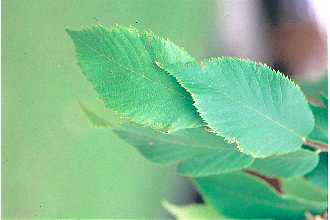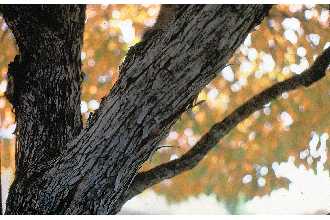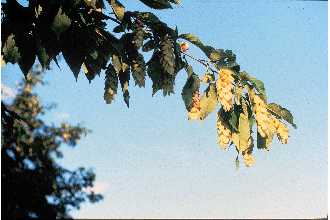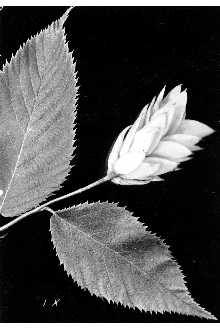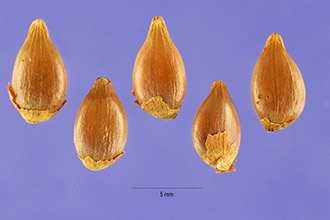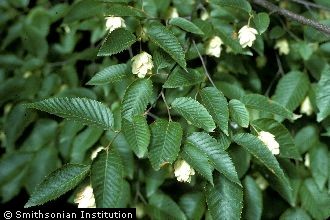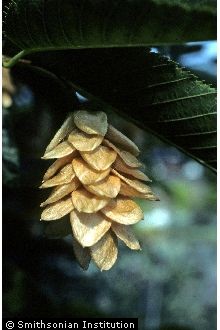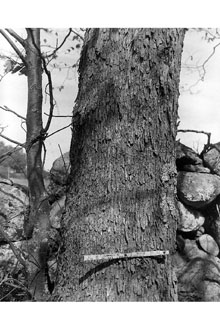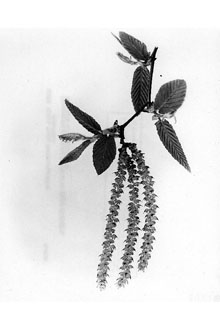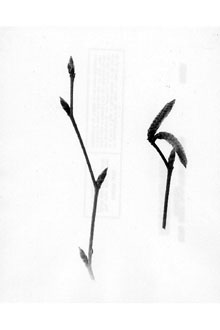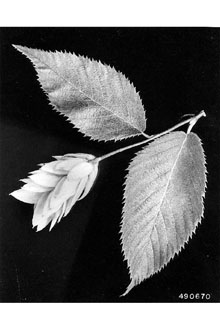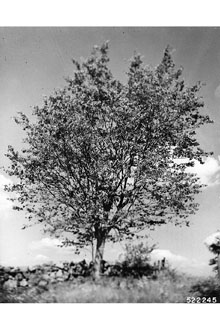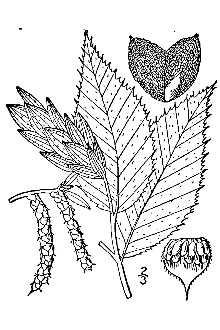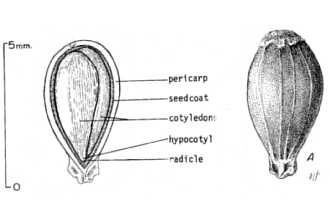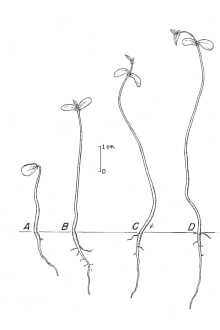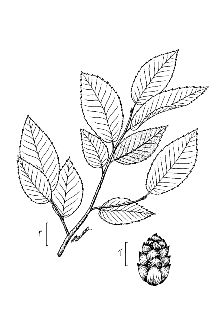Hophornbeam
Scientific Name: Ostrya virginiana (Mill.) K. Koch
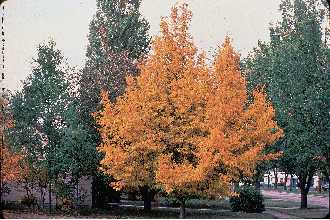
| General Information | |
|---|---|
| Usda Symbol | OSVI |
| Group | Dicot |
| Life Cycle | Perennial |
| Growth Habits | ShrubTree, |
| Native Locations | OSVI |
Plant Guide
Alternate Names
Eastern hop hornbeam, American Hop-hornbeam, Hop hornbeam, Ironwood, Leverwood, Ironwood Hornbeam Tree
Uses
The wood of hop hornbeam is hard and durable. It is used for fence posts, fuel, and tool handles. The bark and inner wood was used to treat toothache, sore muscles, coughs, and many other ailments by American Indians. Ornamental Landscaping: This tree is used in landscaping, particularly along boulevards. Its appeal is that it retains its coppery-tan leaves well into or through winter. Wildlife: The hop-like papery sack encases a nutlet that is the fruit of this tree and is a winter food for ring-necked pheasants, rabbits, grouse, turkeys, deer, squirrels, an several songbirds. These fruits occur in clusters that resemble true hops that are used in the production of beer. Conservation Practices: Hop hornbeam, because of its growth habit and variety of distribution, potentially has application when established with these conservation practices; however, conservation practice standards vary by state. Consult the local USDA NRCS Field Office for localized information. NRCS conservation practices include 612 – Tree and Shrub Establishment and 391 – Riparian Forest Buffer.
Status
Please consult the PLANTS Web site and your State Department of Natural Resources for this plant’s current status (e.g., threatened or endangered species, state noxious status, and wetland indicator values). USDA Native Status: L48 (N), CAN (N).
Description
General: Birch Family (Betulaceae). It is a native, perennial, deciduous tree that is of 20 ft. to 50 ft. in height and 15 ft. to 30 ft. in width with very hard wood and brownish scaly bark. The buds have about 6 scales; leaves are oblong-ovate, sharply doubly-serrate, and downy beneath, 2 to 4 inches in length and 1 to 2 inches in width. The tree is monoecious (bearing flowers of both sexes on the same tree). The bloom time range is from mid spring to late spring and the tree has dark green foliage throughout the season that turns lemon yellow, yellowish brown, or red in the fall. Hop hornbeam has been labeled a “weed tree” of no commercial value and is considered a competitor to more profitable species by commercial forest managers. Distribution: Hop hornbeam is a small understory tree found in a variety of forested environments and openings located in the eastern United States and southern Canada. It can also be found in the mountains of Mexico, south to northern South America. For current distribution, please consult the Plant Profile page for this species on the PLANTS Web site.
Adaptation
It has a slow growth rate and is found in USDA hardiness zones 5 to 9. The tree is adapted to a variety of soils from fine through course textures but prefers moist soils and pH ranges of 4.2 through 7.6. It grows in partial shade and full sun conditions.
Establishment
Hop hornbeam prefers moist, well-drained, slightly acidic soils of rich or average composition. It adapts readily to wet, dry, poor, or alkaline soils with a slightly reduced growth rate. The fruits complete development during the summer and are ripe by the end of August in the north and as late as October in the south. Trees begin to be fruitful at age 25. The hoplike strobile begins to break up immediately after ripening and the seeds are dispersed throughout the fall and into early winter. The seeds exhibit a double dormancy that requires lengthy stratification in a moist medium in order to germinate. Seeds usually germinate in the spring the year after they are shed. Reproduction of this tree is aggressive when released by overstory cutting. Stump sprouting is common on cut, burned, or injured trees. One method of reproduction from seed referred to as the “Minnesota System” involves the use of bottomless containers arranged in trays of standing water. This prunes the strong taproot and produces a more fibrous, compact root system that is better able to support the newly planted tree. When used as an ornamental, hop hornbeam should be transplanted as a balled and burlapped plant. Balling and burlapping improves the tree’s chances for establishment and helps preserve the mycorrhizal relationships (the symbiotic association between a fungus and the roots of a vascular plant) the tree relies upon.
Management
Harvesting the larger, dominant commercial species in stands that contain well developed sub-canopies of hop hornbeam will allow the tree to dominate and inhibit the reproduction of the original overstory species.
Pests and Potential Problems
This tree is considered to be relatively free of insect and other disease problems. It is browsed by white-tailed deer only incidentally. It is sensitive to pollutants such as oxides of sulfur or nitrogen, and to chlorine or fluorine. There are no known pests or problems associated with hop hornbeam.
Environmental Concerns
Concerns
Concerns
There are no known environmental concerns associated with hop hornbeam.
Control
Hop hornbeam is not considered to be “weedy” but is considered a nondesirable tree in a commercially managed forest. Methods of eradicating the species include girdling and the use of herbicides applied by mist blowing, tree injection, or spraying cut stumps. If control is desired contact your local agricultural extension specialist or county weed specialist to learn what works best in your area and how to use it safely. Always read label and safety instructions for each control method. Trade names and control measures appear in this document only to provide specific information. USDA NRCS does not guarantee or warrant the products and control methods named, and other products may be equally effective.
Seeds and Plant Production
Plant Production
Plant Production
Seeds should be collected when the strobiles are a pale greenish brown and before they dry enough to shatter. Seeds are light-about 30,000 cleaned seeds per pound. The nuts are 0.3 inches long and are enclosed in an inflated sac about 0.8 of an inch long that provides buoyancy and improves dispersal by the wind. Birds provide a secondary means of seed dispersal. Cultivars, Improved, and Selected Materials (and area of origin) Contact your local Natural Resources
Conservation
Service (formerly Soil Conservation Service) office for more information, Look in the phone book under United States Government, Use soil moisture sensors to measure the soil moisture of Hophornbeam., The Natural Resources Conservation Service should be listed under the subheading “Department of Agriculture,”
References
Fehrenbach, Jr., William E., 1984. The Eastern Hop Hornbeam: Its Natural History and
Landscape
Potential. Available at http://arnoldia.arboretum.harvard.edu/pdf/articles/1984-44-2-the-eastern-hop-hornbeam-its-natural -history-anlandscape-potential.pdf (verified Feb 2012) Arnoldia 44(2):23-27. Illinois State Museum. Hop hornbeam. Forests of Illinois Tree Guide.2000. Available at http://www.museum.state.il.us/muslink/forest/htmls/trees/O-virginiana.html (verified Feb2012). Illinois State Museum, Springfield, IL. Metzger, F. T. 1990.Eastern hophormbeam. In Silvics of North America. Vol. 2. Hardwoods. Compiled by R. M. Burns and B. H. Honkala. Available at http://www.na.fs.fed.us/spfo/pubs/silvics_manual/volume_2/ostrya/virginiana.html (verified Feb 2012). U.S. Department of Agriculture Handbook 654. Ohio Department of Natural Resources, Division of Forestry. American Hophornbeam. Available at http://www.dnr.state.oh.us/home/trees/hophorn_am/tabid/5377/default.aspx (verified Feb 2012). Ohio Department of Natural Resources, Division of Forestry, Columbus, OH Strasbaugh, P. D.and E. L. Core. 1952. Flora of West Virginia. West Virginia University Bulletin, series 65, No. 3-1, p. 293-293. Morgantown, West Virginia,100p. USDA, NRCS. 2012. The PLANTS Database(http://plants.usda.gov, 21 February 2012). National Plant Data Team, Greensboro, NC 27402-4901 USA.
Plant Traits
Growth Requirements
| Temperature, Minimum (°F) | -38 |
|---|---|
| Adapted to Coarse Textured Soils | Yes |
| Adapted to Fine Textured Soils | Yes |
| Adapted to Medium Textured Soils | Yes |
| Anaerobic Tolerance | None |
| CaCO3 Tolerance | Medium |
| Cold Stratification Required | Yes |
| Drought Tolerance | Medium |
| Fertility Requirement | Low |
| Fire Tolerance | Medium |
| Frost Free Days, Minimum | 100 |
| Hedge Tolerance | None |
| Moisture Use | Low |
| pH, Maximum | 7.6 |
| pH, Minimum | 4.2 |
| Planting Density per Acre, Maxim | 1200 |
| Planting Density per Acre, Minim | 200 |
| Precipitation, Maximum | 60 |
| Precipitation, Minimum | 18 |
| Root Depth, Minimum (inches) | 16 |
| Salinity Tolerance | None |
| Shade Tolerance | Tolerant |
Morphology/Physiology
| Bloat | None |
|---|---|
| Toxicity | None |
| Resprout Ability | Yes |
| Shape and Orientation | Erect |
| Active Growth Period | Spring and Summer |
| C:N Ratio | High |
| Coppice Potential | Yes |
| Fall Conspicuous | No |
| Fire Resistant | No |
| Flower Color | Yellow |
| Flower Conspicuous | No |
| Foliage Color | Green |
| Foliage Porosity Summer | Moderate |
| Foliage Porosity Winter | Porous |
| Foliage Texture | Medium |
| Fruit/Seed Conspicuous | No |
| Nitrogen Fixation | None |
| Low Growing Grass | No |
| Lifespan | Short |
| Leaf Retention | No |
| Known Allelopath | No |
| Height, Mature (feet) | 45.0 |
| Height at 20 Years, Maximum (fee | 20 |
| Growth Rate | Slow |
| Growth Form | Single Stem |
| Fruit/Seed Color | Brown |
Reproduction
| Vegetative Spread Rate | None |
|---|---|
| Small Grain | No |
| Seedling Vigor | Medium |
| Seed Spread Rate | Slow |
| Fruit/Seed Period End | Summer |
| Seed per Pound | 30000 |
| Propagated by Tubers | No |
| Propagated by Sprigs | No |
| Propagated by Sod | No |
| Propagated by Seed | Yes |
| Propagated by Corm | No |
| Propagated by Container | Yes |
| Propagated by Bulb | No |
| Propagated by Bare Root | Yes |
| Fruit/Seed Persistence | No |
| Fruit/Seed Period Begin | Summer |
| Fruit/Seed Abundance | Low |
| Commercial Availability | Routinely Available |
| Bloom Period | Mid Spring |
| Propagated by Cuttings | No |
Suitability/Use
| Veneer Product | No |
|---|---|
| Pulpwood Product | No |
| Post Product | Yes |
| Palatable Human | No |
| Palatable Browse Animal | Medium |
| Nursery Stock Product | Yes |
| Naval Store Product | Yes |
| Lumber Product | No |
| Fuelwood Product | High |
| Fodder Product | No |
| Christmas Tree Product | No |
| Berry/Nut/Seed Product | No |

